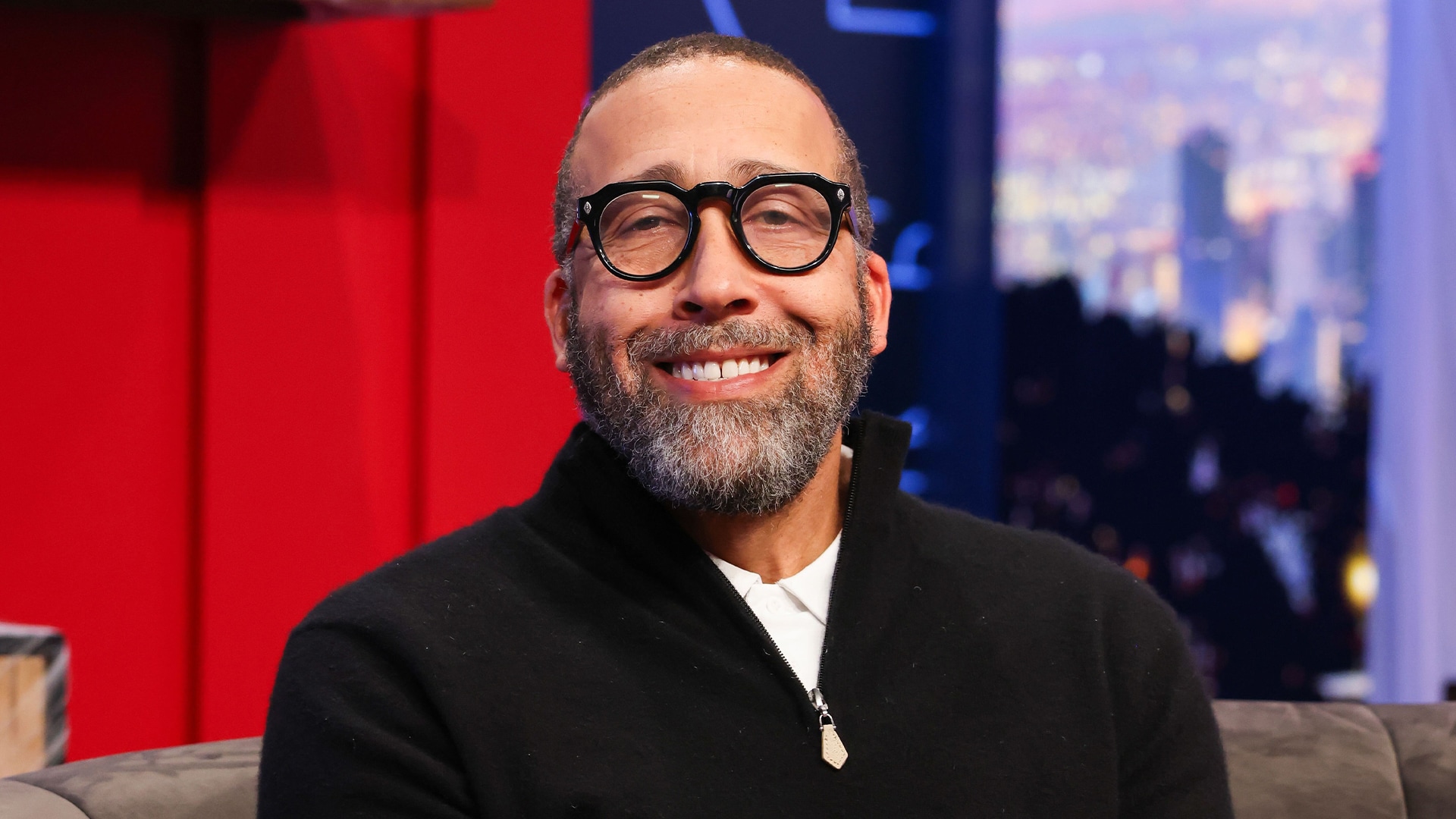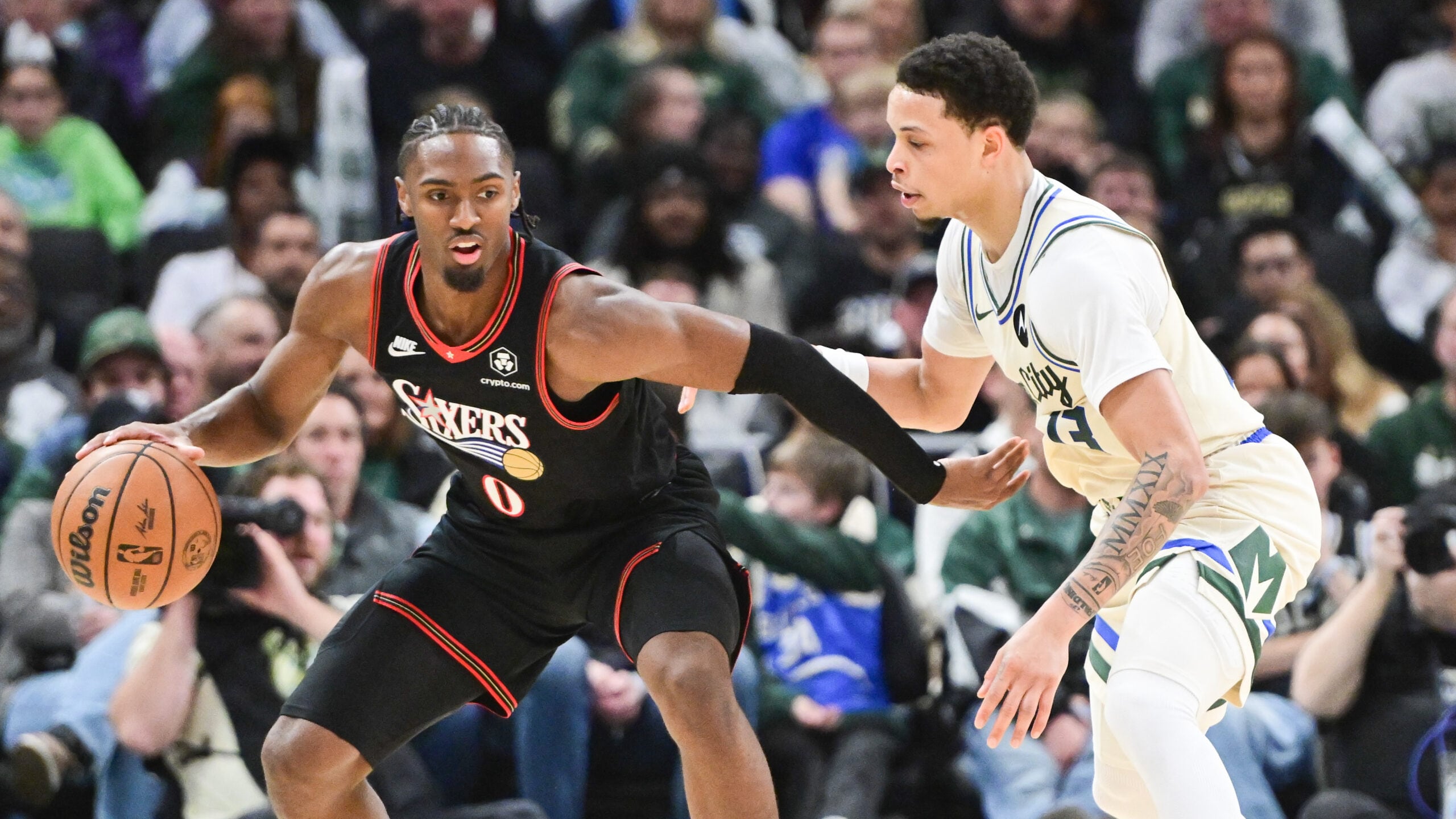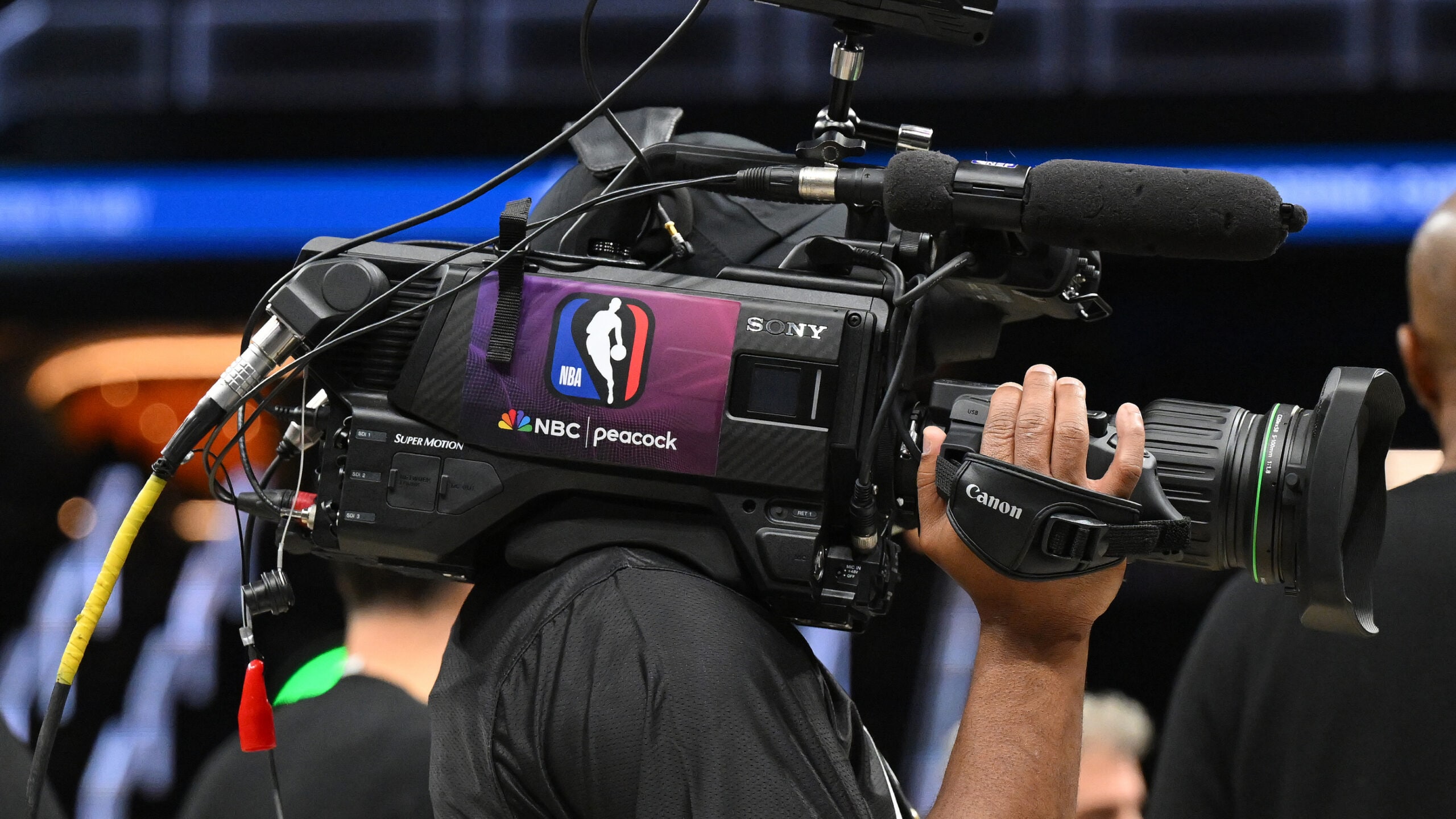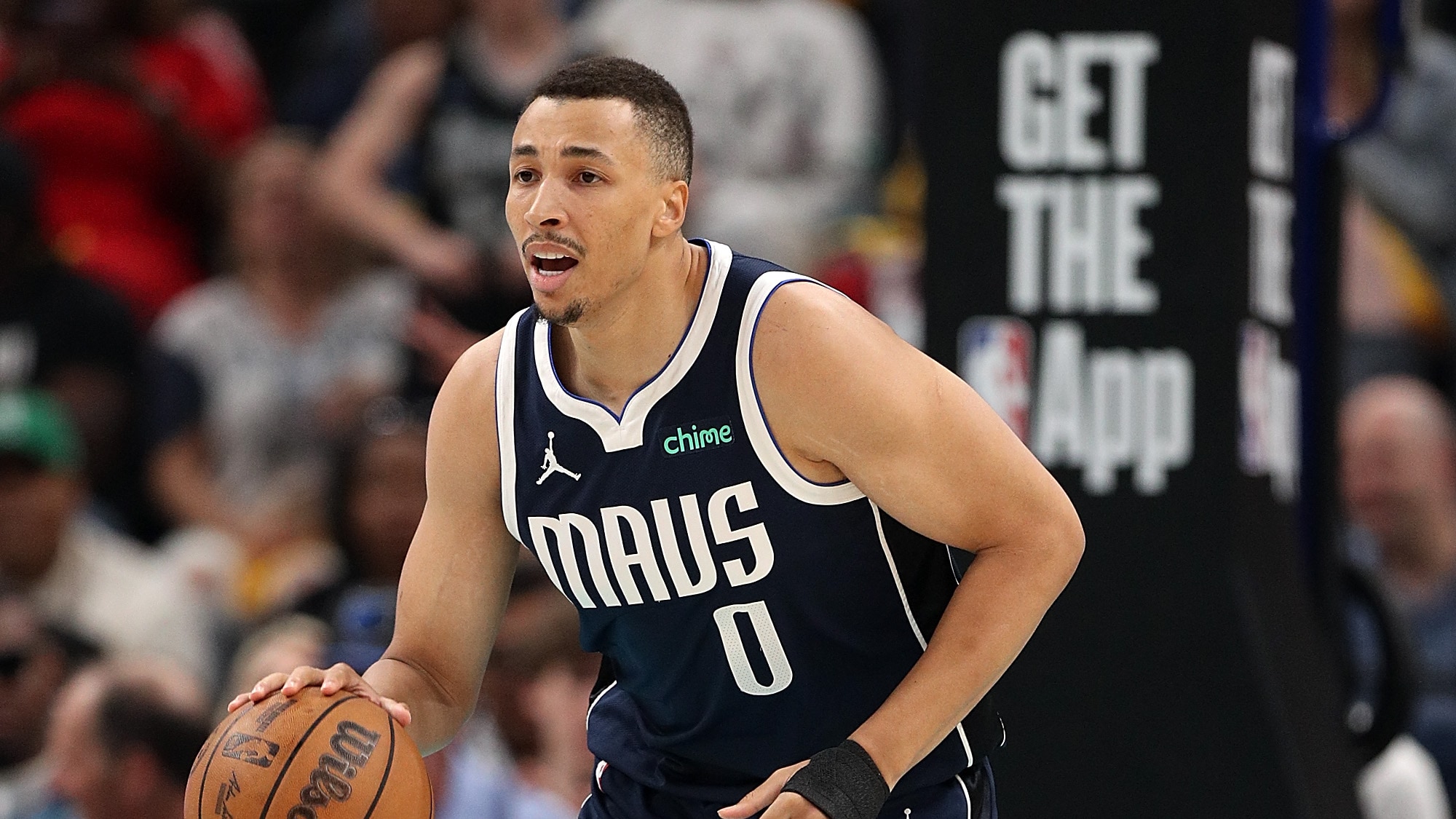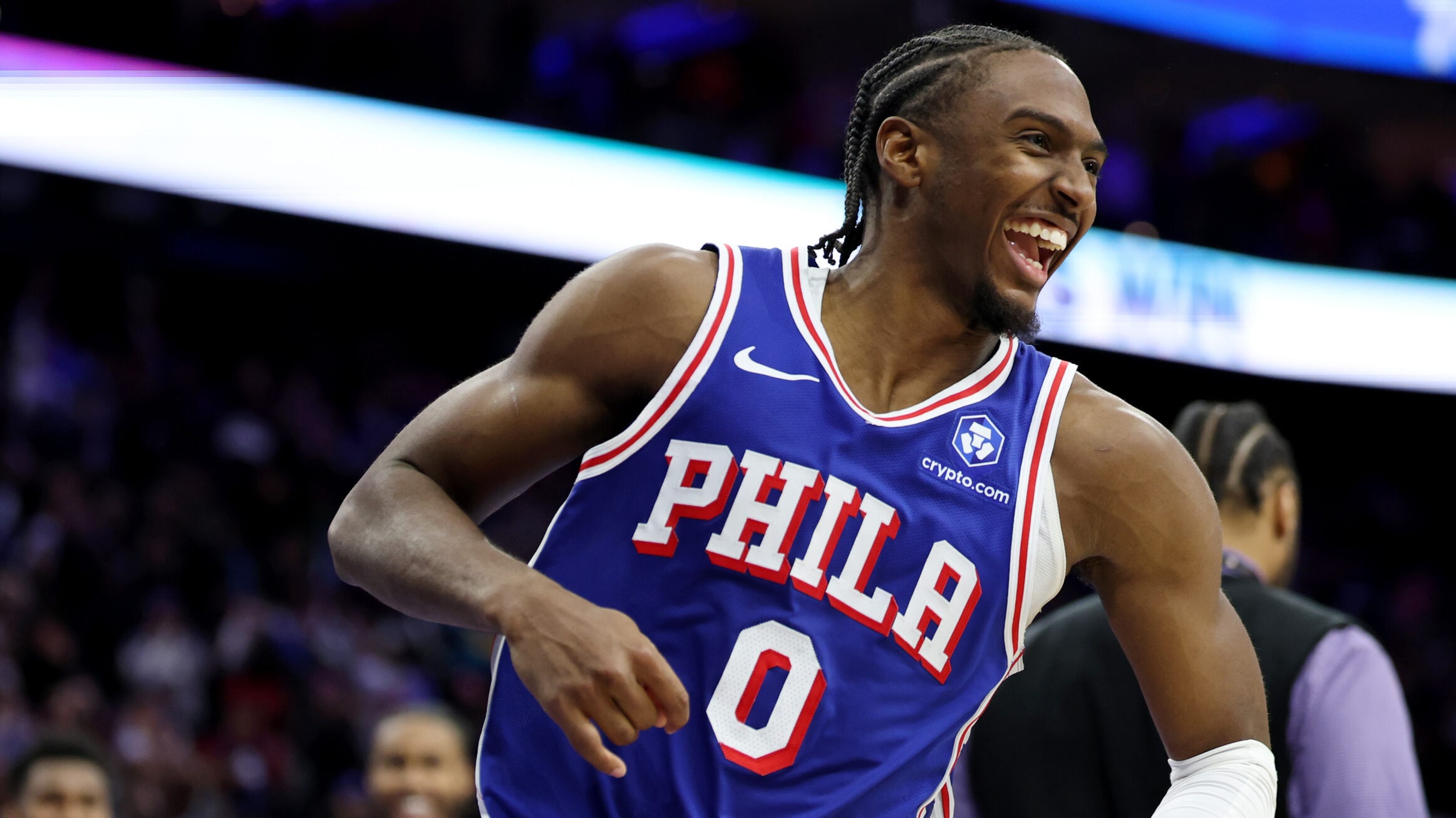Hawks guard Dyson Daniels discusses his move to Atlanta and the big defensive leap he has taken in 2024-25.
When is a theft and a steal slightly different in definition and context? Here’s when:
Theft: What the Atlanta Hawks did to pry Dyson Daniels from the New Orleans Pelicans last summer.
Steal: What Daniels does nightly, effortlessly and historically, for the Hawks.
There’s no criminal connotation that’s usually attached to those words, although strictly from a basketball perspective, what Daniels is doing this season should be against the law.
No one saw this coming. Not the team he left or the team he’s currently helping, and to be honest, not even the player himself. Daniels has snuck up on everyone, much like he does to an unsuspecting ball handler who’s about to get stripped.
In his third season and coming off a promising yet nondescript start to his career, Daniels’ development and impact defensively are sudden and forceful. He’s on pace to become the first player in over 30 years to average 3.0 steals per game. And that doesn’t include his ball deflections, which mostly translate into forced turnovers.
Therefore, at just 22, he’s up for a pair of awards:
Is he the Kia Defensive Player of the Year? Or is he the Kia Most Improved Player?
From an age standpoint, his qualifications for the last one make sense (the first one doesn’t). The ability to defend, and do it well, usually takes years to master in the NBA. He would become the youngest winner (there are four 23-year-old winners) since the award was introduced in 1982-83. The nuances to learn, the discipline it takes to focus (and even the willingness to defend) usually come later.
Also, only eight perimeter players — and just one guard since 1995-96 — have won an award that traditionally goes to rim protectors. And as a 6-foot-7 guard, Daniels is a true perimeter defender who covers the court like sweat.
There’s this: Daniels is also defending the perimeter in the 3-point era, which is far more challenging than 20 or 30 years ago. So much activity takes place well beyond the rim — screens, isolations, 3-pointers — and if anything, rim protectors have it easier because of the lack of elite low-post offensive players to worry about.
Finally: This is the age of minimal physicality. On-ball defenders can’t hand-check or make contact without getting whistled — especially risk-takers like Daniels. Plus, offensive players get away with so much more than before — the hesitation dribble (which was once whistled as palming), the hop-step, Eurostep and/or gather step before shooting, etc. They’re all designed to put the defender at a disadvantage.
Daniels finds success in Atlanta
Being an elite defender requires speed, agility, reflexes, and above all, smarts. It has evolved into art, and right now, Daniels is among the game’s better creators.
Trae Young, Dyson’s somewhat biased All-Star teammate, sees him daily in practices and games, and says:
“Dyson’s the best defender I’ve seen with my own two eyes.”
Anyone who saw Daniels during his two years with the Pelicans perhaps came away with good feelings but also a shrug. As in, Daniels, the No. 8 pick in 2022, had promise … but the NBA graveyard is filled with those types.
The Pelicans ultimately wanted a more seasoned guard, so they swung a 2024 summer deal with the Hawks for Dejounte Murray, a ball hawk and the 2022 steals leader. The Hawks, who surrendered a haul to get Murray from the Spurs in 2022, received Daniels and lesser players, along with two future first-round picks — which were perhaps the best part of the deal then.
But Daniels hit the ground running in Atlanta last fall and hasn’t stopped.
Here are the unimpeachable details:
- Daniels is averaging a league-high 3 steals per game in a season where no one else is getting more than 1.8.
- His game-high in steals this season is eight. He also has a seven-steal game and logged five or more steals in 13 games … and four steals in 12.
- He’s also leading the league in “stocks” (steals plus blocks). The last guard to lead the league in stocks? Michael Jordan in 1987-88, who won Defensive Player of the Year.
- He leads in deflections, the most since the league began tracking the stat. Daniels has 189 more than the next closest this season, Keon Ellis of the Sacramento Kings.
- He leads the league in total “stops” (steals plus blocks plus offensive fouls drawn).
Daniels doesn’t track steals as a way to determine whether he is successful.
“I get more pride when I keep my man to a 25% shooting night, and maybe I get three steals and a block,” he said. “That’s a good night for me. If my guy is going off, shooting 65%, scoring 30 points, then I didn’t do my job that night.”
In that sense, Donovan Mitchell shot 29%, Jayson Tatum 37% and NBA scoring leader Shai Gilgeous-Alexander was 8-for-19 when guarded by Daniels, according to NBA.com/stats.
Elite defense can be explained and quantified in multiple ways. Loading up on steals could also equate to losing those gambles. Reaching for blocks might mean more fouls. And so on.
The best defense, however it’s done, is denying the other team from scoring, whether it’s on-ball or help defense.
Hawks coach Quin Snyder once coached four-time winner Rudy Gobert in Utah. While Daniels and Gobert are vastly different defenders, Snyder knows elite when he sees it.
“There are some ways we’re able to objectively keep track of good defenders, like steals and blocked shots,” Synder said. “There are also other things like beating through the screens to keep your man out of the lane so they don’t generate an advantage. You have to watch the game a little more to see those things. I think that’s harder with the perimeter player. We all focus on the ball when it goes to the rim. You see those things with the rim protector, not the perimeter defender.
“In Dyson’s case, his consistency and focus is just always there.”
A ‘home run’ hitter as a defender
Dyson Daniels hits the hardwood in studio to help the NBA on TNT crew break down intricacies of pick-and-roll defense.
There’s a strategy to how Daniels goes about his business to get steals. It’s at the intersection of patience and opportunity.
“I try to feel their rhythm, where they like to attack and which way they like to go,” Daniels said. “From there, I can read when I can take the contact and poke the ball loose. Once I get that timing down pat, it makes it easier to make that play.”
His signature swipe was against the Grizzlies on March 3. With the score tied at 130, Daniels poked the ball from Desmond Bane with 3.8 seconds left. Even better, in the same sequence, he threw downcourt to Caris LeVert for the winning layup at the buzzer.
Snyder said that play was 47 minutes and 56 seconds in the making.
“I compare it to baseball, where the hitter every at bat learns a little more about a pitcher,” Snyder said. “Then there’s a certain time when they’re able to anticipate a pitch and then boom, home run.
“In Dyson’s case, over the course of a game, he’s able to measure the person he’s guarding and then when he sees an opportunity, at the right time, he takes advantage of it. The fact it was the last play of the game, and what happened after, with the pass, that was amazing too. And Caris knew he was going to steal it because he took off right away.”
The Grizzlies can't get past Dyson Daniels, who picks off the pass and sends it ahead to Caris LeVert for the buzzer-beater.
Daniels concedes there’s a cat-and-mouse game at play whenever he’s assigned to guard a specific player.
“The more I can get into their heads a bit, the more chances I get to poke the ball,” Daniels said. “I’m more consistent with the bigger guys, but there’s no guy that’s easy to get the ball from. Jalen Brunson is very hard, he has a smaller dribble, like Kyrie [Irving]. They’re tough. You got to be careful with those guys.”
Daniels agrees with the commonly held NBA theory that because of the steep skill level, “great offense beats great defense.”
Most impressive is how Daniels, despite being aggressive and a risk-taker, avoids fouls. He’s averaging just 2.4 fouls per game and says the strategy is using his chest more than his hands when the offensive player crashes the lane.
“Not only do fouls hurt the player, but team fouls add up and has the chance to impact the game,” Snyder said. “That goes to his patience and him being aware of the situation and the potential negative impact on your team. Sometimes situations require you to make a play, and other times for you to be patient and smart.”
Daniels will often drift away from his man and pull a sneak attack double team on another, stripping the ball from behind. He has the green light to do that whenever he wants.
“I play the percentages,” Daniels said. “With the in-bound passer, for example, I pretend I’m not looking, then I jump the gun and go get it, using my length and ability to deflect. I’ve been smart with the way I’ve been gambling.”
Daniels: ‘They’re more aware of me now’
Hawks guard Dyson Daniels joins NBA on TNT to discuss his nickname, playing defense and more.
He learned the basics of defense in the NBA Academy while growing up in Australia. Then he combined those lessons with anticipatory instincts he says are natural to develop into what we see now.
The Pelicans were high on him and made him a lottery pick. When the trade with the Hawks was made, he wasn’t thrilled initially — nobody enjoys being rejected — but after embracing the fresh opportunity, all is forgotten.
“I’m over that,” Daniels said. “I know personally I wasn’t myself in New Orleans. I didn’t give them what I’m giving Atlanta right now. They got Dejounte Murray, who’s a really good player. I can see the vision of what they were trying to do. I’m here now, I’m enjoying my time here and trying to make the most of it.”
What tilts that trade in Atlanta’s favor is Daniels is six years younger and (for now) a lot less expensive. He’s also just as good a defender, or already better, and averaging 14 points, six rebounds and four assists this season — all career highs. The Draft picks Atlanta also received are now a throw-in bonus.
The Kia Defensive Player of the Year is hotly contested this season with Oklahoma City’s Lu Dort, Golden State’s Draymond Green and Cleveland’s Evan Mobley all in the mix. Daniels respects them all.
And he notices how most of the top candidates aren’t designated rim protectors, thus a victory for the perimeter players.
“Guys like Lu Dort, Toumani Camara [of the Trail Blazers], these guys don’t get enough credit for what they do on the ball, forcing tough shots,” Daniels said. “The big defenders are appreciated because you don’t want to meet them at the rim, but it makes their job easier when you’re on the perimeter and put pressure on players.
“It works hand in hand. It’s hard to say which one is better. There’s so many good defenders in the league. The award is definitely a big man award, though, I agree on that.”
As with any player who goes next level, there’s a better scouting report on Daniels, and opposing coaches and players now adjust accordingly when they play the Hawks. That’s the drawback. Sneaking up for steals has never been harder.
“They’re more aware of me now,” Daniels said. “But maybe that’s a good thing.”
* * *
Shaun Powell has covered the NBA for more than 25 years. You can e-mail him here, find his archive here and follow him on X.
The views on this page do not necessarily reflect the views of the NBA, its clubs or Warner Bros. Discovery.





